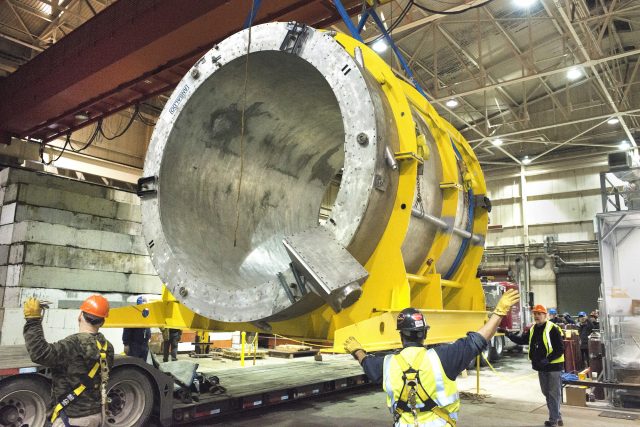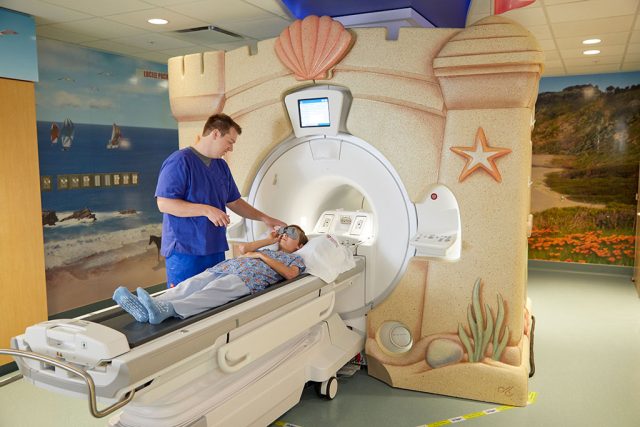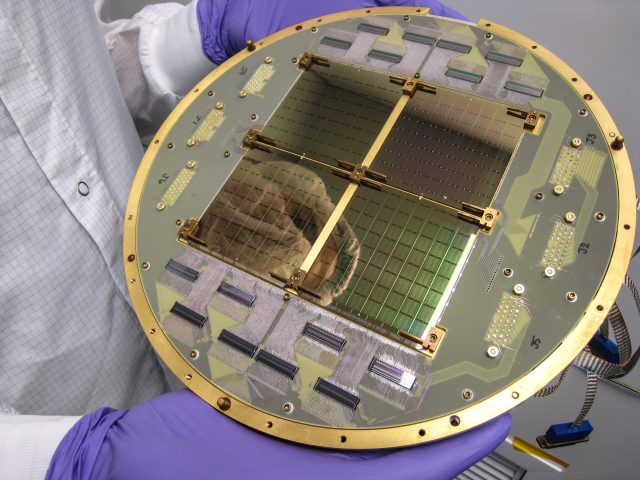by Miguel F Morales: Manipulating quantum devices has been like getting an intoxicating new superpower for society…
The future is already here—it’s just not very evenly distributed –William Gibson
As tool builders, it is only very recently that we’ve been able to use quantum mechanics. Understanding and manipulating quantum devices has been like getting an intoxicating new superpower—there are so many things we can now build that would have been impossible just a few years ago.
We encountered a few of these quantum technologies in the previous articles. Some of them, like the quantum dots in TVs, are already becoming commonplace; others, like optical clocks, exist but are still very rare.
As this is the last article in this series, I’d like to look to a near future where quantum technologies are likely to infuse our everyday existence. One does not have to look far—all of the technologies we’ll explore today already exist. Most of them are still rare, isolated in laboratories or as technology demonstrators. Others are hiding in plain sight, such as the MRI machine at the local hospital or the hard drive sitting on your desk. In this article, let’s focus on some of the technologies that we did not encounter in earlier articles: superconductivity, particle polarization, and quantum electronics.
As we look at these quantum technologies, envision what it will be like to live in a world where quantum devices are everywhere. What will it mean to be technically literate when knowing quantum mechanics is a prerequisite for understanding everyday technology?
So pick up your binoculars, and let’s look at the quantum technologies coming over the next ridge.
Superconductors
In a normal conducting wire, you can attach a battery and measure how quickly the electrons move through it (the current, or number and speed of electrons). It takes some pressure (voltage) to push the electrons through, and doing that pushing releases some heat—think of the red glow of the coils in a room heater or hair dryer. The difficulty of pushing the electrons through a material is the resistance.
But we know that electrons move as waves. As you cool down all the atoms in a material, the size of the electron waves carrying the electric current become larger. Once the temperature gets low enough, this waviness can go from being an annoying subtlety to the defining characteristic of the electrons. Suddenly the electron waves pair up and move effortlessly through the material—the resistance drops to zero.
The temperature at which the waviness of electrons takes over depends on the crystal the electrons are in, but it is always cold, involving temperatures at which gasses like nitrogen or helium become liquids. Despite the challenge of keeping things this cold, superconductivity is such an amazing and useful property that we’re using it anyway.
Electromagnets. The most widespread use of superconductivity is for the electromagnets in MRI (Magnetic Resonance Imaging) machines. As a kid, you may have made an electro-magnet by coiling a wire around a nail and attaching the wire to a battery. The magnet in an MRI machine is similar, in that it’s just a big coil of wire. But when you have ~1000 Amps of current flowing through the wire, keeping the magnet working becomes expensive. It would normally end up looking like the world’s largest space heater.
So the answer is to use a special wire and cool it down in liquid helium. Once it is superconducting, you can plug it into a power source and ramp up the current (this takes 2-3 days—there’s a great video of plugging in an MRI magnet). Then you unplug the magnet and walk away. Because there is no resistance, the current will continue to flow for as long as you keep the magnet cold. When a hospital installs a new MRI, the magnet is turned on when it is installed, then unplugged and left on for the rest of its life.

A superconducting magnet used for a particle detector.
While MRI machines are the most visible examples, superconducting magnets are actually quite common. Any good chemistry laboratory or department will have several superconducting magnets in their Nuclear Magnetic Resonance (NMR) machines and mass spectrometers. Superconducting magnets line 18 km of the Large Hadron Collider and they show up in other ways in physics departments. When we had a shoestring project, we scrounged up a superconducting magnet from the storage alley behind my lab and refurbished it. Physicists are mailed glossy catalogs by superconducting magnet manufacturers.
Transmission lines. The next obvious application is to stretch a superconducting wire out and use it to carry electricity. There are several demonstration projects around the world that use superconducting power lines. As with most industrial applications, it is just a matter of finding cases where the performance of a superconductor is worth its high price. As the price comes down, long distance superconducting transmission lines may become crucial as we add more renewable solar and wind energy to the grid—being able to losslessly ship power long distances can even out the local variations in renewable power production.
Generators and motors. If you have incredibly strong superconducting magnets, you want to use them in electric generators and motors. Cooling, as always, is an issue, but the much stronger magnets can make the motor/generators significantly smaller and more efficient. This is particularly enticing for wind turbines (reduced weight on the tower), and electric drives for boats and aircraft (reduced weight and improved efficiency).

Polarized particles
In the last article, we played a lot with polarized photons. But polarization is an inherent property of most other fundamental particles, too. While photons get opposite polarizations when you turn the polarizer 90° (vertical vs. horizontal), electrons, protons, and neutrons are oppositely polarized when you turn the polarizer 180° (up vs. down). Whether a particle is an introvert or extrovert is closely related to its polarization characteristics. (Polarization at 90° and 180° are not the only possibilities; particles like gravitons are oppositely polarized at 45°, and the Higgs boson has no polarization at all.)
MRI machines work by polarizing the hydrogen nuclei in your body. The single proton in a hydrogen nucleus can be polarized by a very strong magnetic field (preferably from a superconducting magnet). Once polarized, the nuclei can be tapped with a radio pulse and they will ring like a radio bell. The exact pitch of the proton’s ringing depends on the strength of the magnetic field that proton sees (stronger field creates higher pitch).

An MRI images your body by carefully changing the magnetic field and repeatedly listening to the radio ringing of your hydrogen nuclei. The MRI will make the field a little stronger at your head than your feet, ring all the hydrogen, then make the field a little stronger on the left than the right, and ring all the hydrogen again. By carefully listening to how many nuclei are ringing at each pitch in different magnet configurations, it can build up a three dimensional view of where all the hydrogen in your body is. The result? A beautiful map of your insides. (Modern MRIs use additional tricks, as exhaustively explained here.)
I love MRI machines because they rely on quantum mechanics for every aspect of their operation. They use superconductivity to make the strong magnetic field, which causes quantum polarization of the nuclei in your body, and then use a radio ping and ringing related to even more advanced quantum magic. MRIs are inherently quantum mechanical machines.
Quantum electronics
The obvious next step is to play with the polarization of electrons. This is often called ‘spintronics,’ and we’re already using that, too—all modern hard disk drives rely on electron polarization to function.
Conceptually, you can read a hard disk by running a small loop of wire past the tiny magnets on the disk that record the data. The magnets induce a weak electrical signal in the wire, thus ‘reading’ the magnets’ directions. A loop of wire, with a small bit of magnetic iron to boost the signal, is exactly how audio-tape works and was how hard drives worked until nearly the end of the 20th century.

But making a hard disk hold more data means making the magnets on the disk ever smaller; correspondingly, the electrical signal produced in the loop of wire became smaller and smaller until it was at the edge of being undetectable. This led to the use of electron polarization heads (giant magneto resistance in 1997 and tunneling magneto resistance in 2004). Both of these technologies are based on quantum mechanics, and use the polarization of the electron to detect the direction of the magnets on the disk.
You can think of this like passing light through two polarizers. If the polarizers are aligned, most of the light goes through (low resistance); if they are crossed, very little light gets through (high resistance). In today’s read heads, there are two thin layers of iron that act as electron polarizers. One of them has a fixed direction, and polarizes the incoming electrons, while the other iron layer is free to align with the magnet on the disk. As the second electron polarizer switches direction, the number of electrons passing through changes dramatically.
The tunneling magneto resistance heads in current hard drives include electron tunneling between the iron layers for even more quantum goodness. Modern hard drives simply do not work without quantum electronics.
But we can go beyond the polarization of electrons and really leverage the electron waviness. By interleaving thin layers of superconducting and normal materials, we can make the quantum electronic equivalents of transistors and diodes such as Superconducting Tunnel Junctions (SJTs) and Superconducting Quantum Interference Devices (affectionately known as SQUIDs). These devices take full advantage of the wave-like nature of electrons and can be used as building blocks for all sorts of novel electronics.

Because of the superconducting requirement, they need to be kept very cold, but quantum electronics have already revolutionized precision measurement. The most visible application has been in measuring the Cosmic Microwave Background (CMB). Observations of the CMB have shown that we live in an expanding Universe, determined the age of our Universe, and identified the fraction of it composed of dark matter and dark energy. Measurements of the CMB have transformed our understanding of the Universe we live in. These measurements have been largely enabled by SQUIDs and related superconducting electronics in their microwave cameras.
In the world of precision measurement, quantum circuitry is the new normal. Quantum effects are found in the radio amplifiers of dark matter searches, the cameras of x-ray satellites, and can image the working brain using magnetic fields. They also serve as the building blocks of many quantum computers, such as D-Wave and IBM Q.
The quantum world is already here, and is starting to become commonplace.
Living with Quantum Mechanics
So what does it mean to be technically literate when knowing quantum mechanics is a prerequisite for understanding our everyday technology? You have to understand that electrons move like waves to understand how a quantum dot in your TV works. Without quantum mechanics it makes no sense—there is no classical analog. As quantum devices become pervasive, an understanding of quantum mechanics will be required to make sense of our world. For people who do not know quantum mechanics, the answer to “How does X work?” will increasingly become “magic.”
Maybe this is OK? None of us understand how everything we encounter works, and many people are fine with not understanding. Quantum mechanics will enable us to build some wondrous technology—will not understanding how it works detract from its magic?
I suspect some of you will say the whole reason you read this marathon article series is because you want to know why. And no, magic is not a good enough answer!
Perhaps there is a more hopeful answer. Maybe this is but a step on a long road. In the early 20th century, electronics was a new thing, understood only by specialists. Transistors were not invented until mid-century. Now, elementary school children wire up circuits and there are university departments dedicated to teaching it. We have learned how to teach electronics much more broadly as it has become a crucial part of our lives.
Today quantum mechanics is rarely taught outside the physics building. Most college students have never taken a course in quantum mechanics, and popular science videos and articles rarely discuss the gorgeous but advanced topics we explored in this article series. If we want a world where most people can understand the technology around them, we are going to have to figure out how to teach quantum mechanics more broadly.
And so I’d like to close with a huge thank you to you, the reader, for accompanying me on this journey. I have been teaching many of these concepts in an advanced graduate physics class (a year of graduate quantum mechanics is a prerequisite…). This article series is my attempt to take these ideas and present them in a more accessible way. And while it is one thing to say we need to figure out how to teach quantum mechanics to a broader audience, it is much scarier to actually lace up your boots and try and lead a tour. This article series is my attempt to teach the beautiful and subtle aspects of quantum mechanics to a wider audience, and I am so grateful to all of you for your energy and time, and for trooping along with me on this safari through the quantum woods.
FAQ
Can I get the whole series? Yes! The whole series is available here for free, and if you are an Ars Technica subscriber you can download pdfs of the articles.
Ars Technica is a special place—there are very few publishers who are willing to publish long-form science content like this. So if you have enjoyed this series and have the financial means, I’d like to encourage you to subscribe to support this kind of work.
If you’d like to use these articles for teaching, there is an accompanying teaching guide. Someday I would love to publish these as a giftable illustrated book, and maybe even a quantum kit, but there are no current plans.

















































